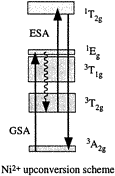Abstract of Publication No. 375
 Oliver S. Wenger and Hans U. Güdel
Oliver S. Wenger and Hans U. Güdel
Photon Upconversion Properties of Ni2+ in Magnetic
and Nonmagnetic Chloride Host Lattices
Inorg. Chem. 40, 157-164 (2001)
![]()
![]()
Abstract:
Near-infrared to visible upconversion luminescence in Ni2+:CsCdCl3,
Ni2+:CsMnCl3, and Ni2+:RbMnCl3
is presented and analyzed. In all three materials upconversion
occurs via a sequence of ground-state absorption/excited-state
absorption processes, which are both formally spin-forbidden
transitions. Consequently, in the diamagnetic Ni2+:CsCdCl3
they are weak, and the efficiency of the upconversion process is
relatively low. This is in clear contrast to the isostructural
Ni2+:RbMnCl3 where the spin selection rule
relaxes because of Ni2+ - Mn2+ exchange
interactions, leading to an intensity enhancement of the
spin-flip transitions involved in the Ni2+
upconversion mechanism. This results in an exchange-induced
enhancement of the upconversion rate in Ni2+:RbMnCl3
relative to Ni2+:CsCdCl3 by 2 orders of
magnitude after two-color excitation into the maxima of the
ground-state and excited-state absorption bands. In Ni2+:CsMnCl3
the Ni2+ - Mn2+ exchange interaction does
not play a significant role. This is due to the different Ni2+
- Cl– - Mn2+ bridging geometry relative to
Ni2+:RbMnCl3. In contrast to Ni2+:CsCdCl3
and Ni2+:RbMnCl3 where the upconversion
luminescence occurs from Ni2+, in Ni2+:CsMnCl3
the upconverted energy is emitted from Mn2+ in the
visible spectral region. This leads to an enhanced visible
upconversion luminescence in Ni2+:CsMnCl3,
relative to the other two samples where Ni2+
near-infrared inter-excited-state emissions compete with the
visible upconversion luminescence.